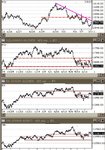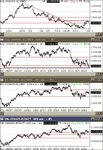dbphoenix
Guest Author
- Messages
- 6,954
- Likes
- 1,266
Posted elsewhere:
Everyone says it: "Keep it Simple, blah blah blah..."
But no one tells us how to keep it simple. If it was that simple, then why doesn't anybody tell us about keeping it simple. Would it be that hard?
Lots of trading magazines and books have already told you that. They tell you to keep it simple by not overcomplicating things with indicators, etc, and if you read enough of them, it all comes down to price, time, and volume along with the basics of stop loss, risk management, etc.
That is the concept, and that is THE SIMPLEST FORM that anyone, including your mentor, is able to tell you. Don't expect someone, including your mentor, to tell you when to buy and when to sell without experiencing the market yourself and further enhancing yourself. Your mentor can tell you so much with trendlines, S/R , or once x setup happens, then price most likely will go up or down. The market changes and can go against you anytime. After you experience the market and actually trade to a point/level of breakeven, you will know how simple -- but not easy -- the market action and trading is.
It's almost like the game of baseball. I tell you it's a simple game. All you do is just hit the ball by swinging the bat when the ball is coming at you, especially a fastball which usually comes in straight and fast, about 95mph, and this pitcher is usually going to give you fastballs. So with this knowledge, you think it's easy and step up to the plate with confidence. Then the pitcher does throw a fastball ball to you. From your perspective, it seems to be coming in at 95 mph. So you take a big swing, but by the time you swing the bat, the ball has already whizzed by you. Sorry, you misjudged it because the ball was coming in at 99, not 95 mph. Could've hit a homerun or extra base hit if you had swung at it a split second earlier.
Then on the next pitch. You are sitting on a fastball, and this time you swing a bit earlier than last time. But sorry, this time you swung too early; the ball is NOT coming in at 99 mph, but at 91 mph, and at a slightly different location. But hey, it's still a fastball. Why did you miss it!??
So you, getting pissed off or a bit pressured and scared, are now waiting for the next pitch, perhaps your last one. This time you will try to time it correctly. The pitch comes in. Ah, it's a slower one, going at about 85 mph. You wait a bit and swing perfectly at the perfect time. But still nothing. The ball drops down suddenly and you are left with nothing but swinging at air. The pitcher (market) psyched you out with a nastly sinker. You lose.
Hey, forget the last pitch, but you had 2 chances to hit a fastball. I even told you he is going to give you fastballs, and I told you the behavior of a fastball a thousand times. But why did you miss it? It's so simple!?? It's direct and it's fast, but watch the speed and also the location where it's about to be. If it's outside your reach, don't swing. If it's within your reach, swing at the location where it's coming in. That's it! See, it's simple, and that's the simplest form I can put it in. Don't understand why you still can't hit the ball!
Hope you get the point.
--bwc













